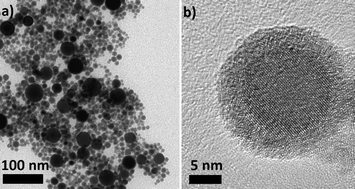In situ X-ray diffraction study on the formation of α-Sn in nanocrystalline Sn-based electrodes for lithium-ion batteries†
Abstract
In situ X-ray diffraction (XRD) was performed to study the formation of the α-Sn structure in nanocrystalline Sn-based electrodes during electrochemical lithium insertion and extraction at room temperature. Therefore, pure β-Sn nanoparticles were synthesised and further processed into electrodes. The lithiation and de-lithiation process of the β-Sn nanoparticles follows the formation of discrete lithium–tin phases which perfectly fits the voltage plateaus in the charge/discharge diagram. However, unlike bulk electrodes, where no α-Sn is formed, we observed the formation of the semiconducting α-modification at 870 mV vs. Li within the first de-lithiation process. This observation explains earlier reports of an increasing internal resistance of such an electrode. Additionally, our study supports earlier suggestions that predominantly small tin crystallites are transformed from the β-Sn phase into the α-Sn phase, while larger crystallites retain their metallic β-Sn structure.



 Please wait while we load your content...
Please wait while we load your content...